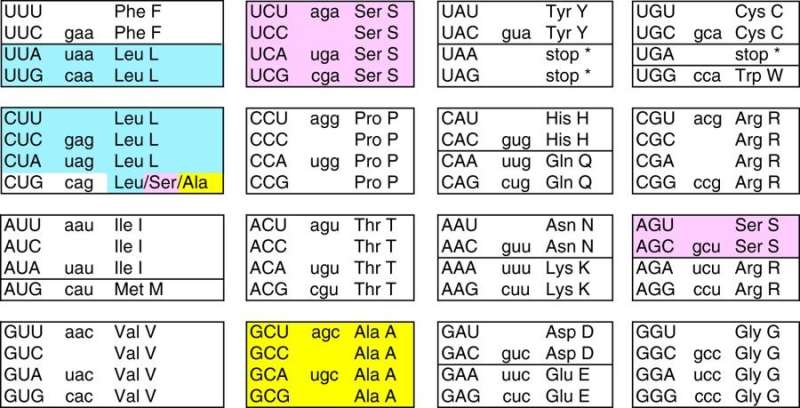In yeasts, the codon CUG can be reassigned to different amino acids. CUG is translated as Leu in the standard code, and as Ser or Ala in the modified codes. Codons are shown in uppercase. Credit: Krassowski et al. Evolutionary instability of CUG-Leu in the genetic code of budding yeasts. Nat Commun. doi: 10.1038/s41467-018-04374-7. CC BY 4.0
Yeasts are some of the most important microbes used in biotechnology. Saccharomyces cerevisiae, the type of yeast used for making bread and beer, is just one representative of more than 1,500 yeast species found around the world. Currently, only a fraction of these yeasts has been harnessed for biotechnological applications. However, researchers studying various "non-conventional" yeast species aim to capitalize on yeast physiology and genetic features to drive biotechnology. In the future, yeasts may play a large role in developing palm oil substitutes, ethanol products, and feedstocks, for example. As discussed below, yeasts are also unique in terms of their genetic code.
We typically think of the universal genetic code as being stable, where mRNA is translated into protein as codons are assigned to either a stop codon or one of the 20 unquestioned amino acids. Occasionally, scientists see departures from this standard code in mitochondria which, because of their own ribosomes and tRNAs, are prone to genetic drift. In nuclear genomes, however, a genetic code change where the amino acid assignment of a sense codon is swapped for a different amino acid is very rare. Until 2016, the only such example in eukaryotes was the reassignment of CUG from leucine (its usual meaning) to serine in budding yeasts.
Then in 2016, JGI researchers discovered a similar switch in Pachysolen tannophilus. A close relative of the well-known yeast genus, Candida, P. tannophilus is a recently-sequenced yeast that can ferment the wood sugar, xylose. As reported in the Proceedings of the National Academy of Sciences, the team discovered another reassignment of the codon CUG. This time CUG was changed from serine to alanine in P. tannophilus. This change was only the second reported case of a non-stop codon reassignment. Scientists are not sure why or how the change came about, but knowing if yeasts' genetic codes are the same is important for gene expression experiments.
Building on this information, another group of scientists followed-up, investigating the phylogenetic relationships in yeasts with standard and non-standard genetic codes. Published earlier this year in Nature Communications, this study looked at the genomes of 52 yeast species, including seven newly sequenced, using whole-genome data and mass spectrometry to determine phylogeny and genetic codes, respectively. Within this data set, researchers observed all three CUG codon reassignments: CUG-Ser, CUG-Ala, and CUG-Leu.
So why is the CUG codon unstable in yeasts? The study authors propose that natural selection caused by a toxin acted specifically against the ancestral tRNALeu(CAG). They hypothesize that this toxin may have come from a Virus-Like Element (VLE). VLEs, the so-called "killer plasmids" code for a toxin and antitoxin and are present in budding yeasts. The authors believe that a VLE with a tRNALeu(CAG)-specific toxin infected the common ancestor of five clades of yeasts. In response, yeast lineages either changed their genetic codes or altered the sets of tRNALeu genes they maintain. If this hypothesis is correct, these genetic code changes represent a profound defense mechanism.
More information: Tadeusz Krassowski et al. Evolutionary instability of CUG-Leu in the genetic code of budding yeasts, Nature Communications (2018). DOI: 10.1038/s41467-018-04374-7
Robert Riley et al. Comparative genomics of biotechnologically important yeasts, Proceedings of the National Academy of Sciences (2016). DOI: 10.1073/pnas.1603941113
Journal information: Nature Communications , Proceedings of the National Academy of Sciences
Provided by DOE/Joint Genome Institute























